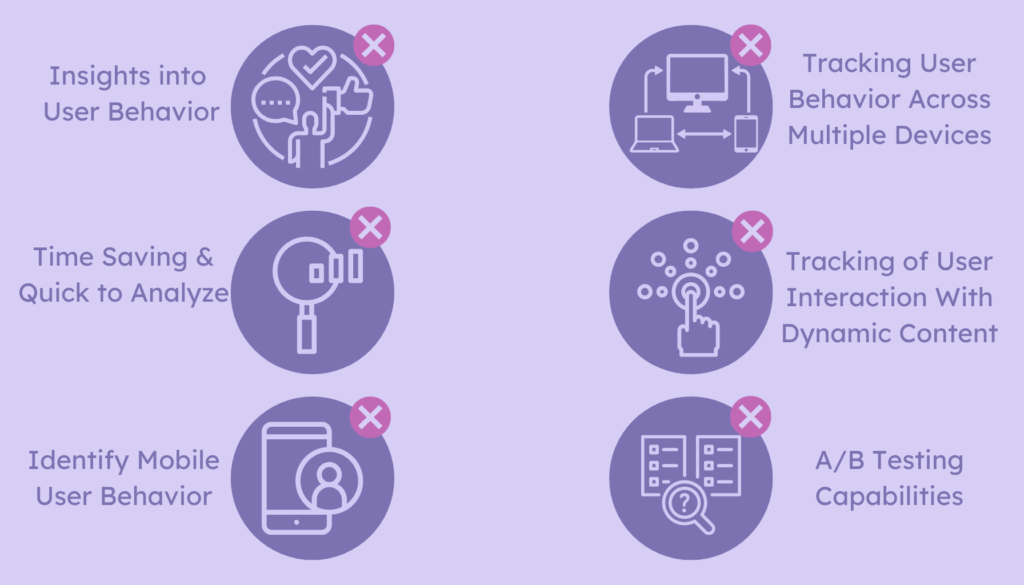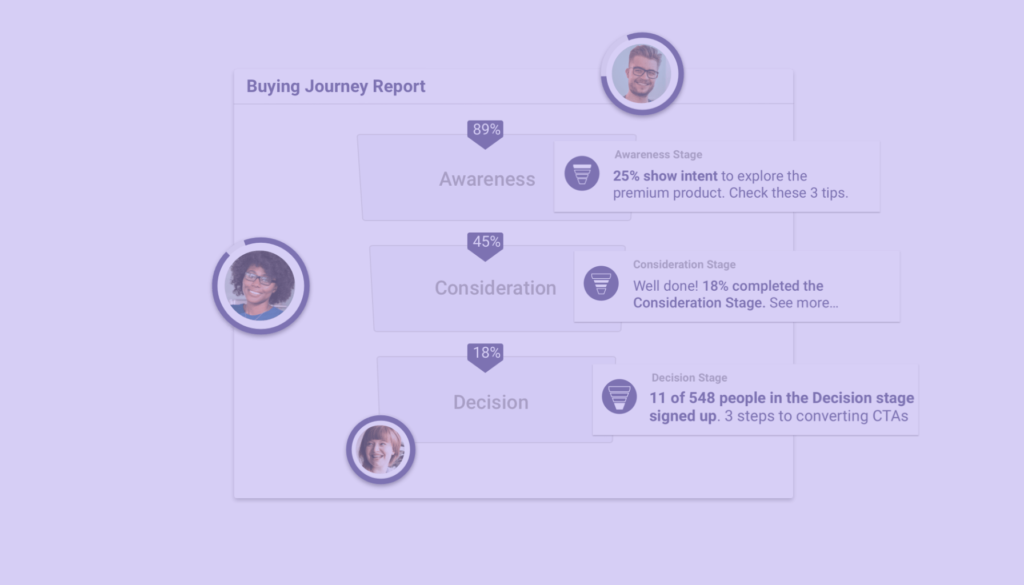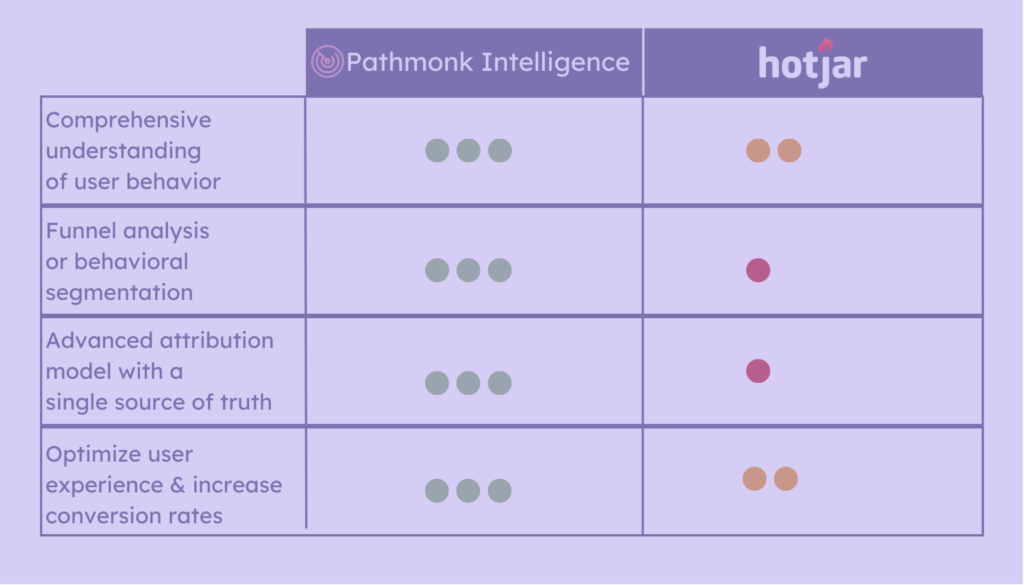
From Guesswork to Precision: How Heatmaps Changed Web Analytics
Before the advent of heatmaps, web analytics was largely a guessing game. Marketers could only rely on their intuition and subjective opinions to determine what worked and what didn’t on their websites. But with the arrival of heatmaps, this all changed.
When heatmaps first arrived on the scene in the early 2000s, they were a revelation. Suddenly, webmasters could see exactly how users interacted with their websites. They could identify problem areas that they never knew existed and make changes to improve the user experience.
For example, a heatmap might reveal that users are clicking on an image that’s not linked to anything, indicating that they expected it to be a clickable link. Armed with this information, the webmaster can turn the image into a link, improving the website’s usability.
Heatmaps also made it possible to test different variations of a website to see which one performed better. This process, known as A/B testing, involves creating two or more versions of a page and randomly showing them to users to see which one performs better. Heatmaps allow webmasters to see which version users are interacting with more, and make data-driven decisions about which variation to keep.
Yes, heatmaps were a game-changer for web analytics. They allowed webmasters to move from a subjective, opinion-based approach to a data-driven, evidence-based approach. They made it possible to identify problems that were previously invisible and ultimately help marketers make informed decisions to enhance the user experience.
Understand your customer journey analytics
See how your users behave, find drop-offs, and receive actionable insights with AI.

The Limitations of Heat Mapping Tools
While heatmaps are an improvement over traditional web analytics, they are beginning to become outdated and obsolete. Heatmaps have several limitations that make them less effective in today’s web environment. So, whether you’re a Hotjar fan or would just like to improve your customer journey understanding, we’ll be diving deep into heatmap limitations, and alternatives.
1. Heatmaps Only Show Limited Insights into User Behavior
A major limitation of heatmaps is that they only provide a limited view of user behavior. Heatmaps can tell you where users click and how far they scroll, but they can’t tell you why users behave the way they do, or their buying intent. They can’t tell you what users are thinking or feeling as they interact with your website.
This limitation is becoming increasingly problematic as websites become more complex and user behavior becomes more nuanced. Today’s websites are more than just a collection of static pages; they’re dynamic, interactive environments that require a deeper understanding of user behavior.
2. Heatmaps are Time-Consuming to Analyze
Heatmaps can generate a lot of data, and analyzing that data can be a tedious and time-consuming process. It can take hours to go through all the data to identify problem areas.
This limitation is becoming more pronounced as websites become larger and more complex. Analyzing heatmaps for a small website might be manageable, but for a larger website with thousands of pages, it can be overwhelming.
3. Inability to Identify Mobile User Behavior
Heatmaps were originally designed for desktop websites, and although many heatmap tools now have mobile versions, they still have difficulty capturing mobile user behavior. Mobile users behave differently from desktop users, and heatmaps often do not capture the full range of behaviors, such as tapping, swiping, or zooming, that are unique to mobile devices.
As a result, relying on heatmaps to analyze mobile user behavior can lead to inaccurate conclusions and decisions. Businesses that fail to consider mobile user behavior in their website-optimization efforts risk losing a significant portion of their audience.

4. Limitations in Tracking User Behavior Across Multiple Devices
Heatmaps only track user behavior on the specific device that they are using, and do not provide a complete view of a customer journey across multiple devices.
Users today often switch between devices, such as mobile phones, tablets, and desktops, and this can lead to incomplete data and a lack of understanding of their behavior. As users continue to navigate across multiple devices to access websites this lack of flexibility and dynamicity is increasingly limiting.
5. Inadequate Tracking of User Interaction With Dynamic Content
Dynamic content is becoming increasingly popular due to its ability to enhance user engagement and increase conversions. However, heatmaps struggle to capture interactions with elements such as drop-down menus, pop-ups, and sliders.
These elements change in real-time and often require user input to trigger them, requiring more complex tracking than traditional heatmap tools can provide, and making it difficult to gain a full understanding of user behavior on a website.
6. Limited A/B Testing Capabilities
Heatmaps are often used in conjunction with A/B testing as they can identify which elements of a website are triggered and which areas are being ignored. However, there are limitations to the insights that heatmaps can provide when it comes to A/B testing. For example, heatmaps cannot tell you why one design performs better than another. They can only tell you how users interact with each design.
Additionally, when it comes to A/B testing, heatmaps cannot provide insights into the impact of changes to website content. For example, if you want to test the impact of changing the wording of a call-to-action button, heatmaps will not be able to tell you whether the change was effective or not.
Heatmaps are also limited in their ability to conduct multivariate testing, which is a technique used to test multiple variations of website elements at the same time. Heatmaps, however, are only able to show how users interact with one version of a website design at a time.
Heatmap Alternative: How AI-Driven Analytics Tools are Revolutionizing User Behavior Analysis
Heatmaps were revolutionary in their own right, but in today’s web environment, businesses need more advanced tools to analyze user behavior and provide actionable insights. That’s where AI-driven analytics tools come in.
AI-driven analytics tools are now taking it further by revolutionizing the way businesses analyze user behavior. By leveraging the power of AI, these tools provide a much more comprehensive view of user behavior, giving businesses deeper insights into what their users are doing and why; filling in all the blanks heatmaps couldn’t.
1. They Offer a More Accurate and Comprehensive View of User Behavior
AI-powered tools can track user behavior in real time, capturing every mouse movement and click. This provides a much more accurate view of how users are interacting with your website and what they’re doing on each page. You can also get a much deeper understanding of user intent. These tools analyze user behavior using machine learning algorithms, providing insights into why users behave the way they do. You can make more informed decisions about how to optimize your website and improve the user experience overall.
2. They Save Time and Effort
Instead of watching hours of recorded sessions, AI-driven analytics tools use machine learning algorithms to analyze user behavior in real time, providing you with actionable insights without the need for manual analysis. This saves time and effort, allowing you to focus on other aspects of your business.

3. They Can Identify Mobile Behavior and Pinpoint Cross-Device Interactions
AI-driven analytics tools have advanced algorithms and machine learning models that enable them to leverage data from multiple sources to provide a more complete picture of the customer journey. These tools can also identify and track user behavior across different devices.
4. They Are Able to Analyze User Behavior with Dynamic Content
AI-powered tools enable you to analyze user behavior with dynamic content just as easily as with static content. These tools can capture every interaction with dynamic content, giving you a complete view of how users are interacting with your website.
5. They Can Conduct More Effective A/B Testing
These tools can track user behavior across different versions of your website and provide insights into what design elements are driving user behavior. This allows you to make more informed decisions about which website design to use.
Hotjar Vs Pathmonk Intelligence
To demonstrate the above, we’re going to compare Hotjar, one of the most commonly used heatmap tools, with Pathmonk Intelligence, a solution specifically designed to leverage the power of AI for smart website analytics.
Hotjar is a popular website optimization tool that includes features such as heatmaps, session recordings, and surveys. One of the main advantages of Pathmonk Intelligence over Hotjar is the use of AI-driven analytics. Pathmonk Intelligence analyzes billions of intent data points to provide a comprehensive understanding of user behavior. This approach is more advanced than the traditional approach used by Hotjar, which relies on collecting data from user sessions and heatmaps. AI-driven analytics can identify patterns and trends in user behavior that may be missed by traditional analytics tools.

While Hotjar provides insights into user behavior, its capabilities are limited compared to Pathmonk Intelligence. For example, Hotjar does not offer features such as funnel analysis or behavioral segmentation, which are included in Pathmonk Intelligence; these are essential to identifying areas of a website that need improvement to ultimately optimize the user experience.
Furthermore, Pathmonk Intelligence offers an advanced attribution model, enabling marketers to have a single source of truth when it comes to data analysis, instead of having to compare complex reports from multiple sources.
While Hotjar is a valuable website optimization tool, Pathmonk Intelligence offers more advanced capabilities for website analysis and optimization. With its AI-driven analytics and advanced features Pathmonk Intelligence provides a comprehensive understanding of user behavior that can be used to optimize the user experience and increase conversion rates.
Conclusion
While heatmaps were a great improvement over traditional web analytics, they are becoming increasingly outdated as websites become more complex and user behavior becomes more nuanced. Heatmaps struggle to provide a comprehensive understanding of user behavior and can only offer a limited view of how users interact with a website, wasting valuable time and resources.
On the other hand, AI-driven analytics tools like Pathmonk Intelligence are able to provide a deeper understanding of user behavior by analyzing billions of intent data points. These tools offer a range of benefits over heatmaps, including the ability to identify mobile user behavior, pinpoint cross-device behavior, and track user interactions with dynamic content. Additionally, AI-driven analytics tools can offer insights into why users behave the way they do, providing businesses with actionable insights to improve their website design and overall user experience.
Understand your customer journey analytics
See how your users behave, find drop-offs, and receive actionable insights with AI.









